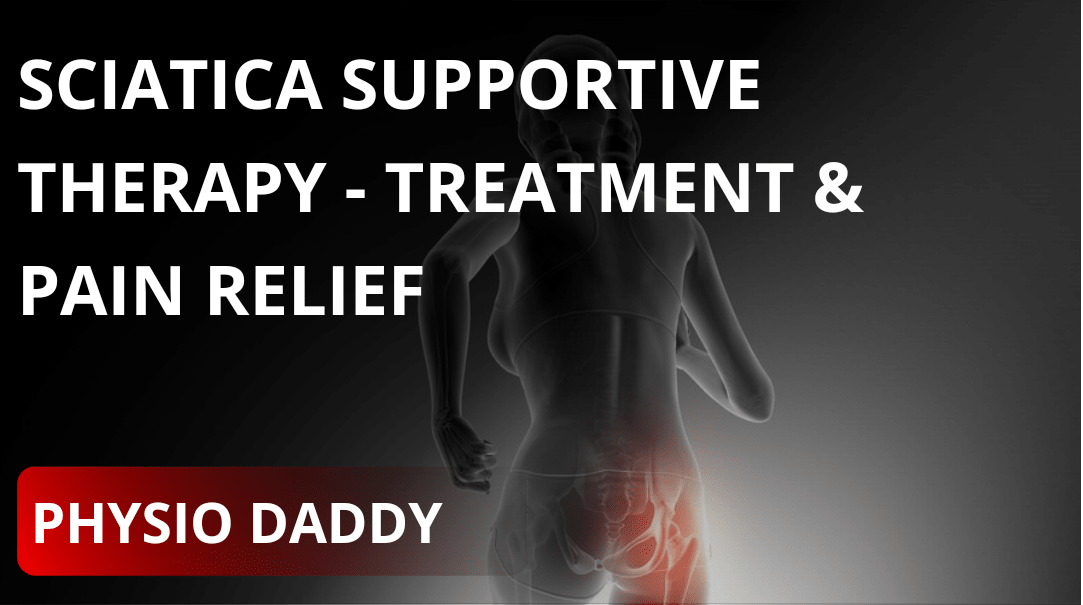Sciatica, characterized by radiating pain along the sciatic nerve, is a common condition affecting millions worldwide. While medical intervention is crucial, supportive therapies can play a pivotal role in managing symptoms, promoting healing, and enhancing overall well-being.
In this blog post, we delve into the various aspects of sciatica supportive therapy, exploring effective treatments and pain relief strategies.
Let’s first Understand Sciatica:
Sciatica originates from compression or irritation of the sciatic nerve, typically caused by herniated discs, spinal stenosis, or other spinal issues.
The resulting pain, ranging from mild discomfort to debilitating agony, often extends from the lower back down the leg.
Supportive Therapies for Sciatica
1. Physical Therapy:

- Strengthening Exercises: Physical therapists prescribe exercises targeting the core and lower back muscles. Strengthening these muscles provides better support to the spine, reducing pressure on the sciatic nerve.
- Flexibility Exercises: Stretching routines focus on improving flexibility, which can alleviate stiffness and tension in the affected area.
2. Heat and Cold Therapy:

- Heat Application: Applying heat to the affected area increases blood flow, relaxes muscles, and reduces pain. Hot packs or warm baths are common methods.
- Cold Application: Cold compresses or ice packs help reduce inflammation and numb the area, providing relief from sciatic pain.
3. Chiropractic Care:

- Spinal Adjustments: Chiropractors perform targeted adjustments to realign the spine, aiming to alleviate pressure on the sciatic nerve. This can result in reduced pain and improved mobility.
4. Acupuncture:

- Needle Stimulation: Acupuncturists insert thin needles into specific points along energy channels in the body. This stimulation is believed to promote the body’s natural healing processes and may help alleviate sciatic pain.
5. Massage Therapy:

- Deep Tissue Massage: Professional massage therapists use deep tissue techniques to target and release tension in muscles surrounding the sciatic nerve.
- Improved Circulation: Massage enhances blood flow, delivering nutrients to the affected area and promoting healing.
These supportive therapies aim to address both the symptoms and underlying causes of sciatica, providing a holistic approach to pain management and recovery.
It’s important for individuals to work closely with healthcare professionals to determine the most suitable combination of therapies based on the severity and specific characteristics of their sciatic condition.
Regular communication with healthcare providers ensures that the treatment plan can be adjusted as needed for optimal results.
Other Pain Relief Strategies:
1. Over-the-Counter Medications:
Nonsteroidal anti-inflammatory drugs (NSAIDs), such as ibuprofen and naproxen, are commonly used for pain relief and to reduce inflammation. They work by inhibiting the production of certain chemicals that contribute to pain and swelling.
2. Prescription Medications:
In cases of severe pain or inflammation, healthcare professionals may prescribe muscle relaxants. These medications help alleviate muscle spasms and tightness associated with sciatica. Corticosteroids, either orally or through injections, can also be prescribed to reduce inflammation around the affected nerve.
3. Ergonomic Adjustments:
Creating an ergonomic environment involves making adjustments to daily activities and surroundings to support the spine and reduce sciatic pain. This includes using chairs with proper lumbar support, maintaining good posture while sitting or standing, and ensuring workspaces are ergonomically designed to minimize strain on the lower back.
4. Weight Management:
Maintaining a healthy weight is crucial for managing sciatic pain. Excess weight can exert additional pressure on the spine and exacerbate symptoms. Weight loss through a combination of a balanced diet and regular exercise can help alleviate strain on the lower back and contribute to long-term pain relief.
5. Mind-Body Techniques:
Yoga and mindfulness meditation are holistic approaches that can complement medical treatments. Yoga incorporates gentle stretching and strengthening exercises, promoting flexibility and relaxation. Mindfulness meditation focuses on being present in the moment, helping individuals manage stress and reduce the perception of pain.
These pain relief strategies are often integrated into a comprehensive treatment plan tailored to the individual’s needs.
It’s crucial for individuals with sciatica to consult with healthcare professionals to determine the most effective combination of strategies for their specific condition.
While medication provides symptomatic relief, lifestyle modifications and mind-body techniques contribute to overall well-being and may have long-lasting effects on managing sciatic pain.
Conclusion:
While sciatica can be a challenging condition, a comprehensive approach involving both medical treatment and supportive therapies can significantly enhance the healing process. It’s essential for individuals experiencing sciatic pain to consult with healthcare professionals to tailor a treatment plan that suits their specific needs.
By incorporating these supportive therapies into daily life, one can navigate the challenges of sciatica with the goal of long-term pain relief and improved quality of life.



Pingback: Effective Lumbar Spondylosis Exercises for Enhanced Spinal Health